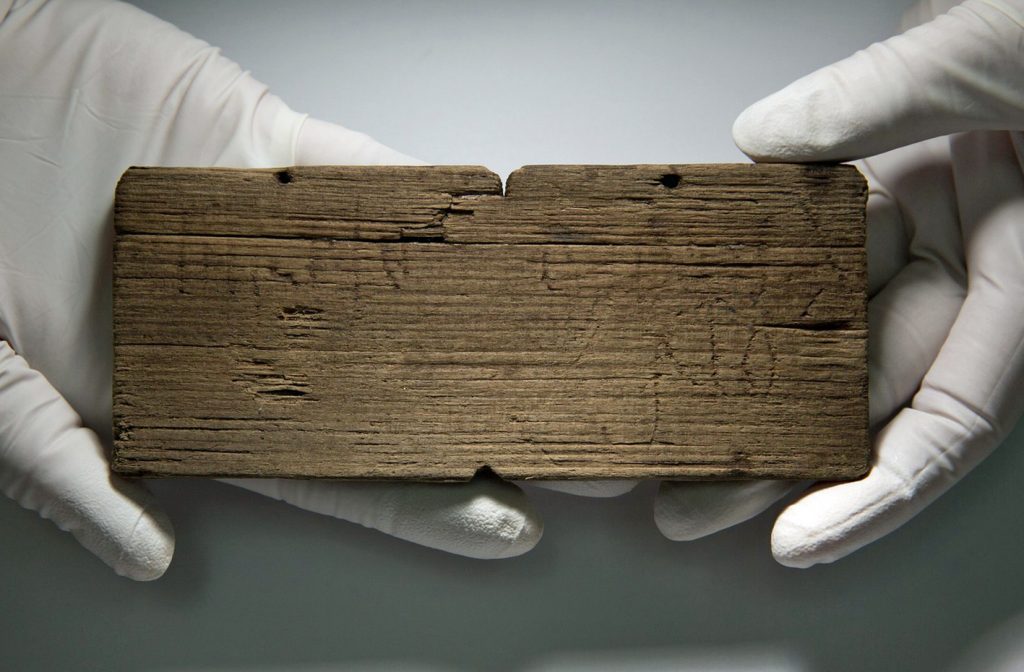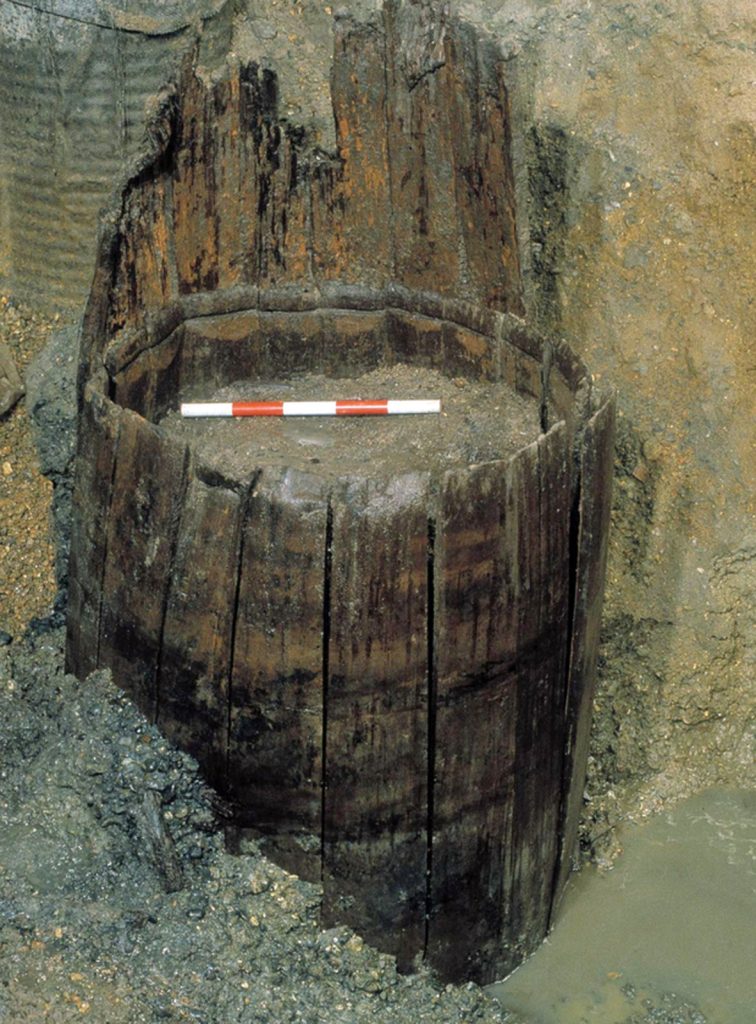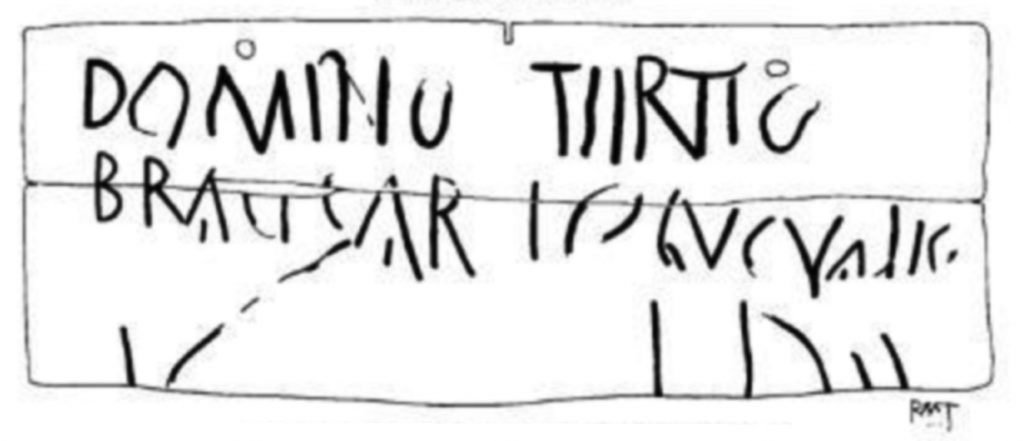It looks as if the history of brewing in London can now be taken back to the very earliest decades of the city’s existence, with the discovery of what is claimed to be the city’s – and Britain’s – earliest known brewer, named on a writing tablet from nearly two millennia ago, found in waterlogged ground on a building site 500 yards to the east of St Paul’s Cathedral.
The writing tablet, used as a letter, was one of 15,000 artefacts found when the Museum of London Archaeology (MOLA) put 50 archaeologists to work betwee 2010 and 2014 digging through thousands of tons of wet mud on a three-acre site between Queen Victoria Street/Bucklersbury and Cannon Street during the early part of the construction of a new European HQ for the media company Bloomberg.
The site, which was previously the home of a 1950s office block, is on the course of the Walbrook, the long-buried river that runs from the border of Hoxton and Shoreditch down between Ludgate Hill and Cornhill to the Thames. Although much of the modern river’s flow is culverted, enough water still soaks the ground to leave it anaerobic, which stops wood, leather and other organic materials from rotting away. More than 400 writing tablets in total were found in the mud and debris of the site, 87 of which still carried legible writing scratched into the wood. The gems included one from around AD65 to 75 addressed “Londinio Mogontio”, “To Mogontius in London”. This is the earliest known mention of London by name, up to half a century before the previous earliest known mention, when Tacitus included the city’s name in his Annals, written around 115-117AD. Another tablet, from around AD80-90/5 has been hailed as the first record of a brewer in London.

There is one small problem – the tablet is addressed Tertio braciario, “to Tertius the braciarius“, and while MOLA has happily translated bracearius as brewer – that is what the word meant in Medieval Latin – it comes from the Celtic word braces, which means either “grain for malting” or, more likely, just “malt”. Archaeologists, apparently over-awed by the authority of the Roman writer Pliny, who referred to braces as the Celtic name for a specific variety of grain, spelt wheat, seem reluctant to accept that he was wrong, and braces probably meant malt in general, made from any grain. Today, in modern Irish, the word for malt is braiche, and “maltster” is braicheadóir while the modern Welsh word for malt is brag, and “maltster” bragwr, all words clearly derived from braces. Braciarius may thus be better translated as “maltster” rather than brewer.
“Maltster” is certainly how the word was translated when it was found in the writing tablets uncovered late last century at the Roman fort at Vindolanda, in modern Northumbria, not least because another term meaning “brewer”, cervesarius, derived from the Latin for beer, cervesa (itself from a Celtic word), appears in the Vindolanda tablets. A fragment of an account of purchases for soldiers at the fort, probably from around AD 97-103, includes a mention of Atrectus ceruersar[ius], “Atrectus the Brewer”, a man with a Celtic name, who was, before Tertius, Britain’s earliest known named brewer. The same word meaning “brewer” – cervecero is still found in Spanish.
Meanwhile braces is mentioned several times in the Vindolanda tablets, including one lengthy letter from a trader called Octavius to another called Candidus, possibly written early in AD 122, covering all sorts of goods, including one significant reference to bracis excussi – “bracis excussi habeo m[odios] cxix …”, “I have 119 modii of excussi bracis”. The translators of the Vindolanda tablets suggested excussi, from the verb excutio, literally “shake, strike (something) out of (something else)”, meant “threshed”, so bracis excussi would be “threshed grain”. But if, as it almost certainly did, braces meant malt, then excussi is likely to refer to deculming, knocking off the rootlets that had sprouted from the grain as it underwent the malting process, so bracis excussi would then mean “deculmed malt”. No brewer would want to buy malt with the culms still on: they need removing or they give a bad taste to the beer. (A modius was a volume measure equal to just under two gallons, incidentally, so 119 would be the equivalent of about 28 and a half bushels, around 1,200 pounds in weight, enough to make very roughly 450 gallons of beer.)
This identification of braces with malt means that the Vindolanda translators were happy to translate an address on one tablet from circa AD92-97, Vindoland[ae] Optato [b]raciiario A Montano fr[at]re as “At Vindolanda, to Optatus the maltster, from his brother Montanus”. (The spelling of braciarius with a double i probably reflects a pronunciation ending “ee-yario”). So if Optatus the braciiarius is called a maltster, why is Tertius the braciarius called a brewer?
On the other hand, the derivatives and descendants of the Celtic word braces show constant overlap between meanings to do with malting and words to do with brewing. For example, while the Welsh for malt is brag, the verb for “to brew” is the obviously related bragu (bracha in the variety of Welsh spoken in North Wales), bragwr means brewer as well as maltster, and brewery is bracty, that is, “malt house”. “Beer” in Welsh, meanwhile, is cwrw, from the same old Celtic root as cervesa. Old French had a word brais meaning “grains préparés en vue de brasser la bière”, in other words, “malt”, but the modern descendants of braces in French are brasser, “to brew”, brasseur, “brewer”, and brasserie “brewery”. (Cervoise in French, incidentally, refers specifically to unhopped ale, though the Spanish and Portuguese words derived from cervesa both mean “beer” generally.) Maybe calling Tertius a brewer, rather than a maltster, can be justified on the grounds that both Celtic and Latin-derived languages, later at least, failed to distinguish between malting and brewing as trades, so perhaps Londoners in the second half of the 1st century AD did the same. And it doesn’t fundamentally matter: if he was only a maltster, he was certainly selling his product to brewers in London, and early Roman Londoners, as we shall see shortly, were certainly drinking beer.

There is one piece of evidence to suggest that Tertius might indeed have been a brewer. The wooden head-piece of half a barrel, probably larch or silver fir, dated by dendrochronology to AD63-4, was found in 2005 at the bottom of a well shaft in the London Clay in 2005 by archaeologists from MOLA working for the developer Land Securities at a site in Gresham Street in the City. The head-piece was 1.2 metres wide and made of five boards, with one scored with the name “TIIRTI[VS]”, “Tertius”. Barrels and brewers go together. But Tertius – which is simply the Latin word for “third” – was a common name in the era, and the cask might have belonged to a different Tertius than the braciarius
The fact that Tertius was a common name, indeed, makes me dubious about the claim from MOLA that Tertius the London braciarius “is surely to be identified with Domitius Tertius”, a braciarius who had a writing-tablet letter addressed to him at “LVGVALIO”, a mis-spelling of the Latin name for Carlisle, Luguvalium, which was found in an archaeological dig in Castle Street, Carlisle in 1981/2 and dated to around AD80 to 95, the same time-span that covers the London Tertius’s letter. It’s possible, certainly, but a long way from definite that they were the same man.

Not all the tablets found in the Bloomberg dig were letters: another found on the site, dating from AD65/70-80, was used to record an account for ceruesa, beer, either owed to or owed by a man called Crispus. Two other men were involved in the transactions listed, with one transaction going “through” Butus, and the other “through” Januarius. It looks as if Crispus could have been buying the beer, so we may have the name of London’s earliest known tavern keepers. The sums being paid, five denarii in one transaction, seven in another, one and a half denarii in a third, imply large amounts of beer, at the price being paid in Vindolanda of one denarius for 200 sextarii, a sextarius being 546ml, or 0.96 of a pint. Seven denarii, therefore, would buy 168 gallons of beer.
What did that beer come in? Casks, very likely. Another tablet from the site is addressed dabes Iunio cupario cotra Catullu[m], “You will give this to Junius the cooper, opposite [the house of ] Catullus”. A cooper was not necessarily a “wet” cooper, making barrels for brewers, but some of the (apparently) wine casks recycled into well linings found during archaeological digs in the City show the Romans knew how to make large waterproof casks.
In Roman times the Bloomberg site was only 100 metres from the Thames, and the mouth of the Walbrook: today the edge of the Thames is 300 metres away from the site, and the Walbrook exits into the Thames through a huge hinged iron door close by Cannon Street Station. The Walbrook was an important asset to Roman London, supplying it with fresh water. The water that still apparently flows down the river’s route outside the Victorian-era drainage system, while a blessing to archaeologists, because the water keeps out oxygen that would otherwise help rot and corrode items buried in the ground, is also a curse: to quote from the archaeologists’ own blog,
“The slightly annoying and inconvenient water levels do mean that organic and metal finds are amazingly preserved … On other sites, copper coins are usually corroded lumps of green; however on our site they are golden-coloured perfect examples. And our timbers are not just dark stains in the ground as you usually find, but lovely solid pieces of oak. So on site we love the Walbrook, but we also loath it at the same time. It provides us with so many happy positive memories of the site, but also so many terrible wet muddy ones.”
The muddy state of the ground is also the reason why so much Roman junk can be found along the line of the old Walbrook. The Romans built right up to the Walbrook’s edge, sinking piers to support their buildings, and then back-filling with any old rubbish they could gather up to try to combat the sogginess and tendency to slip away of the land they were building on. That rubbish included broken pottery, animal bones, old shoes, old tools – and broken writing tablets. A Roman writing tablet was a hinged affair made of wood – often recycled barrel staves – with one side recessed, and filled with a thin layer of blackened beeswax. A message was scratched with a stylus into the wax, leaving white letters on a black background, and if it was a letter, the address would be written on the outside of the tablet when it was folded over to protect the message. The wax has generally disappeared after 2,000 years, but the stylus has often left an imprint in the wood, and sometimes this imprint can be read – though you need to be an expert in Roman cursive script, obviously, and also someone with enormous knowledge of Roman society and a clear and logical mind, to fill in as many of the inevitable gaps as can be filled. Hurrah, then, to Dr Roger Tomlin, the Wolfson College, Oxford University academic responsible for transcribing what was found.
When the Bloomberg building is finished in 2017, the writing tablets and more than 700 other artefacts are to be displayed in a public exhibition space in the building. Meanwhile, if you’re interested, you can read all the tablets, and all about the dig, by buying Roman London’s first voices: writing tablets from the Bloomberg excavations, 2010–14 from the MOMA site for just £32.

Impressed as ever by pure detail! Much obliged…
It would, of course, be possible for Tertius to have been both maltster and brewer. Enough breweries in more recent times had maltings attached and I have seen evidence in wills of premises having both a malthouse and brewing vessels (in large farms)
Oh, very likely.
Dear Martyn,
Interesting history!! I think Peter Krafft suggestion that Tertius was not only a malster but also a brewer might be correct as that is what also used to be the case before the infrastructure was established what happened was that each brewery had their own malting ?
Cheers,
Gerard
Wow! Another amazing article that was beyond fascination. Being a “modern brewer” the information intrigues me being that us human being loved our beer then as now….awesome and amazing! Thanks!
Loved this article. One of your best!
What a fascinting, insightful article. Loved the photo of the barrel.